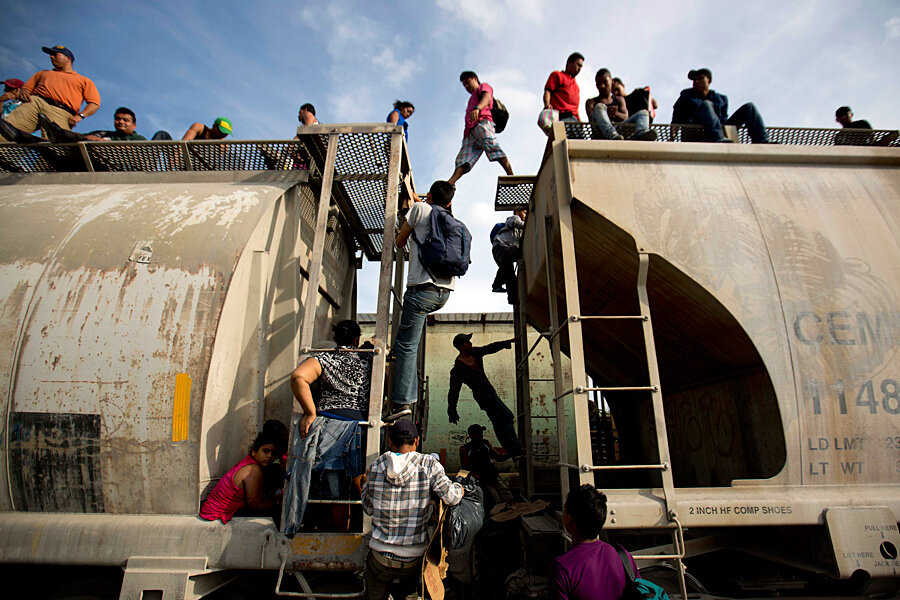Central American migrants: Is immigration to US all it's cracked up to be?
• A version of this post ran on the author's blog, centralamericanpolitics.blogspot.com. The views expressed are the author's own.
David Stoll has a good contribution to the unaccompanied minors debate over at the Wall Street Journal (h/t @mdmcdonald) with The Economics Behind the Border Pile-Up. I don't think that the title accurately covers all Mr. Stoll writes about in the piece but economic motivations/disruptions is certainly part of it.
For the most part, Stoll wants us to include a discussion of the negative consequences that the movement of people from Central America to the US causes back in the region. There is inflation as the remittances sent home really distort local economies and there is the break up of families as men often head north leaving wives and children behind. Even family reunification in the US runs its own risks.
In the Guatemalan town where I do research, approximately 20% of the working-age male population has departed for the U.S. Some men are paragons and send home every dollar they can. Thanks to their remittances, some children eat better, are better clothed and schooled. But remittances are never a secure income stream, and not merely because of U.S. deportation policies. Many migrants fail to find steady work. Some fall victim to cheap beer and other amusements. The longer they stay in the U.S., the more likely they are to start a second family.
One way to hold the original family together is for the mother and children to come north. But family reunification is no panacea even when it can be done legally. When an earner remits to his wife and children in Central America, the money goes much further than it does in the U.S. Once everyone reaches El Norte, even two parents working for the minimum wage may not be able to support a family. So their children get an education in downward mobility and relative deprivation, which is one reason immigrants brought here as boys run a high risk of being sucked into gangs.
Stoll's work is mostly in Nebaj (here's an earlier post from Stoll on Migration from Nebaj) where gang violence is less of a motivation for those leaving than economic necessity and family reunification. That is somewhat consistent with DHS reports of economic motivations causing people to flee from Guatemala and gang motivations causing people to flee from El Salvador and Honduras. Given that is the case, I'd be careful how much to generalize from Nebaj to the entire Central American experience.
It is important to add to the entire immigration narrative that successful (divided families, remittances that distort local economies) and unsuccessful (injury, death, crushing debt) migration to the US both cause problems back in Central America. Just like there are positive and negative consequences from documented and undocumented migration in the US, the same is true for the effect on the towns/countries from which the migrants came.
However, I'm not aware of the evidence that two working immigrant parents makes matters worse for the entire family in the US (see paragraph two above) – increased poverty in absolute and relative terms and a greater likelihood that your children will join gangs in the US. That is what he says, right? Is he arguing that family reunification is worse than just having one family member in the US sending money back to Guatemala? It's plausible and it's not my research area but it just doesn't entirely sound right to me.
Was it really necessary to bash immigrant rights activists?
Immigrant-rights activists insist that unauthorized border-crossers are victims of human-rights abuses. If migrants have not been victimized by their countries of origin, the argument goes, they must have been victimized by U.S. border agents' attempt to stop them. Advocates also argue that migrants have been displaced by wrongheaded U.S. policies, such as supporting dictatorships or free trade, so the U.S. has a moral obligation to accept them.
Look, I don't always agree with the activist left but this seemed unnecessary to the overall theme of the op-ed. Immigration often causes problems that go unnoticed in the media, and family reunification might not be the panacea that some hope it to be. It seems an unnecessary cheap shot (not that I haven't been guilty myself).
Anyway, it's another unique contribution to the public immigration debate.





